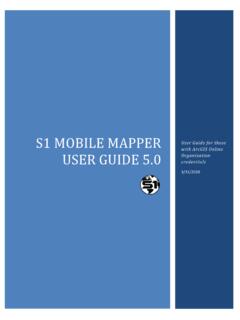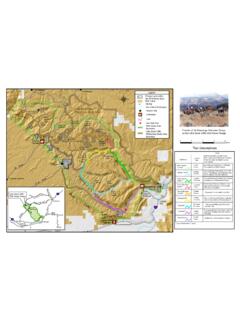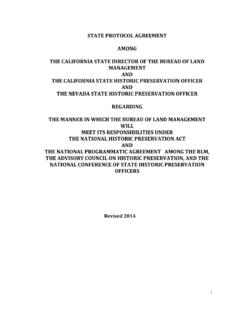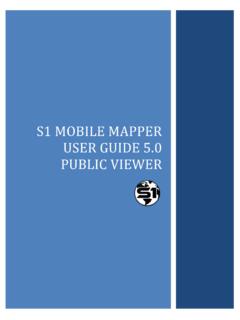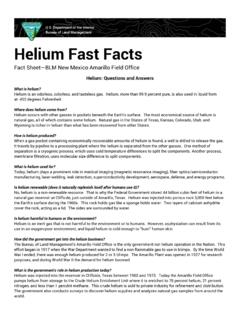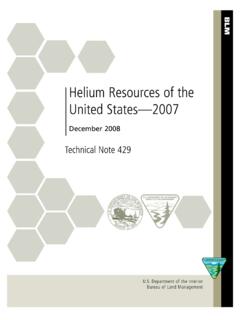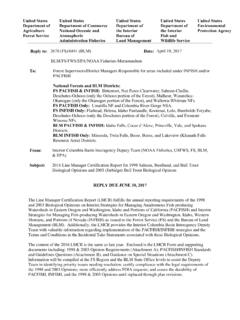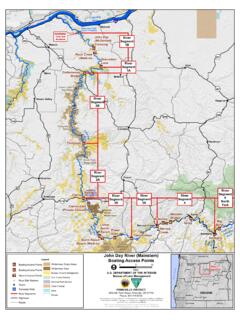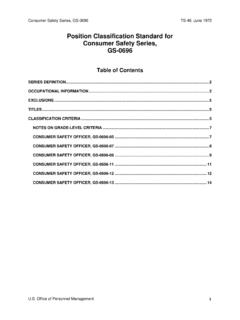Transcription of Chapter 5 – Drilling and Production Operations
1 Surface Operating standards and Guidelines for Oil and Gas Exploration and Development Chapter 5 Drilling and Production OperationsGeneral Operating standards and ObjectivesOnshore oil and gas lease Operations are subject to applicable laws, regulations, lease terms, the Application for Permit to Drill (APD), APD conditions of approval, Onshore Oil and Gas Orders, Notices to Lessees, and orders and instructions of the authorized officer. These include, but are not limited to, conducting Operations in a manner that ensures the proper handling, measurement, disposition, and site security of leasehold Production and protecting other natural resources, environmental quality, life, and property.
2 The primary objective is to maximize the ultimate recovery of oil and gas with minimum waste and with minimum adverse effect on the ultimate recovery of other mineral resources, other natural resources, and environmental and sales reports must be filed with the Minerals Management Service (MMS), as appropriate, under regulatory requirements at 30 CFR Subpart B, using Oil and Gas Operations Report (OGOR), Form Completion ReportA Well Completion or Recompletion Report and Log, Form 3160-4, is required to be filed within 30 days after completion of a well either for abandonment or Production . The well completion report must reflect the mechanical and physical condition of the well.
3 Geologic information, and when applicable, information on the completed interval and Production is Well OperationsProductive wells and service wells periodically require repair and workover Operations that may or may not require prior approval or subsequent notification. The operator should contact the surface management agency to confirm local requirements when surface disturbance activities are requiring the prior approval of BLM s authorized officer include: deepening, plugging-back, non-routine fracturing jobs, recompletion in a different interval, and conversion to a service well. If there is additional surface disturbance, the proposal must include a Surface Use Plan of Operations .
4 A subsequent report of Operations must also be filed for these Operations following completion of the , such as routine fracturing or acidizing jobs or recompletion in the same interval, do not require prior approval if such Operations do not involve additional surface disturbance and conform to standards of prudent operating practice. However, a subsequent report of Operations must be filed for these Operations . Surface Operating standards and Guidelines for Oil and Gas Exploration and DevelopmentNo prior approval or subsequent report is required for Operations such as well cleanout or routine Operations .
5 The required form for obtaining approval or reporting subsequent Operations is Sundry Notices and Reports of Wells, Form 3160-5 (Appendix 2). For more detailed information on reporting requirements, refer to 43 CFR wastes are to be treated or disposed of in an approved manner consistent with existing laws and regulations. Modifications of Production handling equipment may require the submittal of a new site facility diagram or may require a new site security ProceduresFor Operations requiring prior approval by the surface management agency or the BLM, the operator must submit a Sundry Notice or APD, as applicable.
6 With the appropriate form, a detailed written statement of the plan of work must be provided to the authorized officer. When additional surface disturbance is proposed that was not previously authorized for the well pad or right-of-way, a description of any subsequent new construction, reconstruction, or alteration of existing facilities, including roads, dam sites, flowlines and pipelines, pits, tank batteries, or other Production facilities on any lease, must be submitted to the authorized officer for environmental reviews and approval. On FS-administered lands, the BLM will coordinate with the FS to obtain its approval on surface disturbing repairs may be conducted without prior approval provided the authorized officer is promptly notified.
7 Emergency repairs are defined as actions that are necessary in order to avoid threats to human safety or the environment, or to prevent significant loss of royalty income if such actions were delayed until prior approval could be given by the BLM authorized Startup NotificationOperators will notify the authorized officer by Sundry Notice (Form 3160-5) or letter no later than the fifth business day after any well begins Production anywhere on a lease site or allocated to a lease site, or resumes Production in the case of a well that has been off Production for more than 90 days as required by Onshore Order No.
8 4 for oil and Onshore Order No. 5 for of ProductionAll oil, other hydrocarbons, and gas produced from the leased lands are to be put in a marketable condition to the extent economically Production must be measured by tank gauging, positive displacement metering system, or other methods acceptable to the authorized officer. No oil is to be diverted to a pit except in emergency situations or with prior approval from the authorized officer. Oil in the pit must be recovered promptly, and the pit must be kept reasonably free from surface Production must be measured by orifice meters or other methods acceptable to the authorized officer.
9 The flaring or venting of gas from leasehold Operations must meet the requirements of Notice to Lessee, NTL-4A: Royalty or Compensation for Oil and Gas Lost, or an applicable Onshore Oil and Gas of Produced WaterProduced water from leasehold Operations will be disposed of by subsurface injection, lined or unlined pits, surface discharge into channels or impoundments, or other methods, including beneficial use, acceptable to the authorized officer and in accordance with the requirements of Onshore Order No. 7, Disposal of Produced Water, and other Federal or State of produced water often requires permits from State agencies or the Environmental Protection Agency (EPA), in addition to authorization by the BLM under Onshore Order No.
10 7. Disposal or use of water produced from Federal wells must be approved by the BLM before such Operations begin, even if the operator has approval from the surface management agency. In cases of water disposal into pits or other impoundments, the structures must Surface Operating standards and Guidelines for Oil and Gas Exploration and Development conform to approved construction requirements in accordance with Onshore Order No. 7, BLM Manual 9172, and applicable State agency requirements. Pits, water impoundments, and surface dis-charges that present a potential hazard to humans, livestock, wildlife, and other resources should be subject to appropriate mitigation, such as fencing, netting, caging, or covers, as appropriate.
